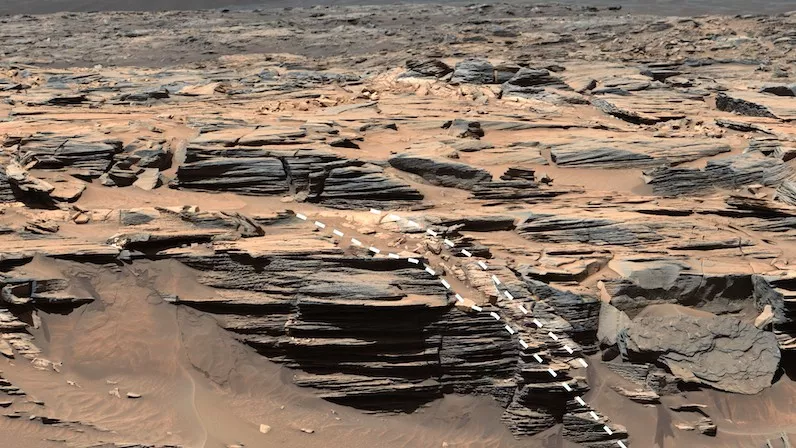A Crater On Mars Is Full Of Opals, And Researchers Expect Life To Exist

A new study has found that the mysterious "halos" of rocks surrounding fissures in a crater on Mars may be made of water-rich opals.
New data from NASA's Curiosity rover suggests that an ancient, dried-up lake bed on Mars may be full of gems.
The cracked surface of this crater, called Gale Crater, gives off a gem-like luster. These opals may be evidence of the interaction of water and rocks beneath the surface of Mars. That raises the possibility that microbial life has existed there, according to a study published in the Journal of Geophysical Research.
Scientists often focus on water when looking for signs of extraterrestrial life because it is essential to life as we know it, but since water no longer flows on Mars, scientists are looking for geological signs of ancient water.
These signs are found in the rocks and soil of the Red Planet, as some minerals and structures form in places where rocks interact with water.
Researchers discovered one of these signs in the past few years around some cracks on the surface of Mars. Some of these rifts are surrounded by "halos" of light-colored rock, which the researchers found is often rich in opal. To form opals, silica-rich rocks must react with water.
Scientists sifted through Curiosity's vast archive of images and found that these opal-rich halos are not isolated, and appear to be present all around Gale Crater, an ancient 154-kilometer-wide lake floor discovered by Curiosity in 2012.
"Our new analysis of the data showed similarities between halos around faults that we observed later in the mission," said lead author Travis Gabriel, a USGS researcher. The fault networks that were so widespread and possibly filled with opals were incredible.”

Gabriel and his colleagues studied old images taken as Curiosity passed around Gale Crater and noticed, in an image taken early in the mission, a halo of light from rock surrounding one of the cracks.
That aura looked exactly like the auras found recently. Data from the Curiosity rover's ChemCam instrument, which analyzes the rocks using images and spectrometry, showed that the rocks mostly contain silica-rich opals.
To confirm the chemical composition of these rocks, the team conducted additional analysis of another group of halos at a different location in the crater called Lubango. The team used the Curiosity rover's Neutron Dynamics instrument, which measures neutrons emitted from the Martian surface by cosmic rays, high-energy particles from outside the solar system that are constantly falling on Mars.
These neutrons bounce off the presence of hydrogen, which is one of the main components of water. If the instrument detects a higher percentage of slow-moving neutrons, that means there are more water-containing rocks, such as opals, in the area.
Results of measuring volatile neutrons at the Lubango site confirmed that the light-colored halos do indeed contain opals, as do other sites around the crater.
This data, along with images of fracture halos that appeared early in the mission, tells us that water must have been present in the crater until relatively recently.
“Given the widespread rift networks detected in Gale Crater, it is reasonable to expect that these subsurface conditions that may have allowed life have extended to many other regions of Gale Crater as well, and possibly to other regions of the crater,” Gabriel said. Mars. These environments formed long after the ancient lakes in Gale Crater dried up.”
The discovery of water in the crater long after the lake had evaporated means that life could persist there a little longer, possibly until Mars' geologically recent period, which began 2.9 billion years ago. Mars is believed to be approximately 4.6 billion years old.

These findings add to previous evidence that water was ubiquitous on Mars. To better understand the planet's watery past, the authors suggest that these opal-rich fissures in the Gale-Cartier crater represent a new destination for geological sample collection, or for potential human exploration missions.
Source : sites internet

